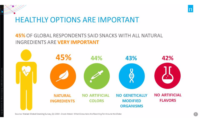For the past decade, quietly, subtly but persistently, Americans have become more and more adventurous in their eating habits, be it embracing Korean BBQ, slurping up Asian noodle dishes, discovering Indian curried specialties or reaching deep into regional Mexican cuisines.
In doing so, the flavors at disposal to confectioners and candy technologists have become bolder, brighter and even better-for-you. That doesn’t mean the standby favorites — such as chocolate, caramel, strawberry and vanilla — have disappeared.
So what’s driving this exploration and explosion in the flavors world? Is it the Millennial generation, weaned on a brave new world of interconnectivity via the Web? Is it driven by ageing Baby Boomers’ travel lust and ongoing pursuit of premium products? Has the culinary world simply expanded its horizons beyond the traditional basics of French, Italian and Chinese cuisines?
Yes to all of the above. Consider Synergy Flavors’ forecast of the hot new flavors of 2018:
- Burnt caramel: According to Mintel, Millennials are interested in different profiles, ethnic infusions and the inferred flavors that are imparted by using specific preparation techniques like caramelization, burning or browning. A burnt caramel flavor pairs the sweet, milky notes of the caramel with the deep and slightly smoky characteristics of burning the caramel. This flavor creation process allows consumers to distinguish the burnt and caramel flavors while enjoying one finished product that combines the best of both.
- Blood orange: Blood orange appeals to consumers by tapping into their growing demand for naturally grown and better-for-you ingredients. Besides the provocative and enticing name, consumers also enjoy how juicy and flavorful blood orange is as compared to the more common Valencia orange flavor.
- Elderflower: Floral flavor use in food and beverage applications has grown 88 percent over the past year, as reported by Mintel. One of these increasingly popular floral flavors is elderflower. Unlike some other floral flavors that can be overwhelming, elderflower’s sweet, subtle profile allows consumers to enjoy it as a standalone flavor. Synergy expects to see increased demand for elderflower flavoring, especially in baked goods and other sweets.
“In the past, we’ve seen these flavors used as toppings for desserts or as part of a combination of ingredients in liqueurs, but we believe 2018 will be the year that these flavors will be seen widely on restaurant menus, on grocery store shelves and at cocktail bars as standalone flavors,” says Greg Kaminski, executive research chef at Synergy Flavors.
“2018 will be an exciting year for exploring new and different flavors in a vast array of food and beverage applications, driven by consumer demand and continued effort on the part of industry food scientists, artisans and manufacturers to strive for new and creative options,” he adds.
Bell Flavors & Fragrances’ (BF&F) annual Spark trends provide a bit broader view of what we can expect this year:
- Touched by the Mediterranean takes us on a journey around the Mediterranean Sea as we hug the Northern coast, filled with an abundance of fresh seafood, and learn the various citruses, crafted-liquors, cheeses and seasonings reigning from this region.
- Healthy-ish explores what’s nutritionally good and making it (actually) fun to eat by exploring those healthier alternatives and flavor enhancers that create well-balanced and tasty dishes but also make food selection decisions kind of “healthy-ish.”
- Longitude and Latitude imaginary lines across the globe create a grid of exploration and intrigue for many chefs with the need to learn about new ingredients and flavors.
- Outdoor Social features foods and beverages that can and should be enjoyed everywhere, and it seems like we all enjoy it just a smidgen more when that “place” is outside.
- A Wok Through the Provinces isn’t just about crab rangoons and fried rice - the world is finally discovering the robust culinary repertoire of China’s eight food regions and their palette-tickling diversity.
As the headline intimates, there’s no holding back when it comes to flavors. But do these exotic excursions actually make it into confections? Perhaps not as quickly as they might in beverages, but there’s certainly more experimentation than ever.
“New flavor ideas are led by the consumer or by chocolatiers simply being creative and confident with their skills,” says Paul Young, chocolatier and U.K. brand ambassador for California Prunes. “Anything goes right now, especially savory ingredients in chocolate, boiled sweets, fudges and toffees. For example, bacon fudge and chocolate, chocolate crisps/chips, and savory spice blends. Moroccan and Indian spices are especially popular due to their fragrant aromas and flavor-blending characteristics.
“Alcohol is huge,” he adds. “But with a mixologist angle of transforming cocktails, craft beers and small-scale distillery spirits into exciting new chocolates and sweets. Herbs are still big business with some of the more forgotten varieties, such as hyssop, dandelion, angelica and traditional florals making a welcome return.”
Amongst all these wonderful flavor concepts, however, there are also more down-to-earth concerns involving clean label and organic reformulations, price and availability fluctuations, and sweetener alternatives.
Converting flavor components from artificial ingredients to natural can be more expensive, says Jenna Schowalter, sweet applications manager for BF&F, particularly if it involves citrus.
“The citrus industry in Florida and California has seen frost, blight and drought, which translates into a volume decrease in fruits harvested,” she points out.
According to data sourced by the USDA and Citrus Industry.net and provided by Synergy Flavors, orange and grapefruit oil prices will remain at historic highs. Orange for processing tonnage has declined by 45 percent since the 2012/2013 years. The reductions are blamed on “greening disease,” which destroys fruit and trees. Of course, Hurricane Irma didn’t help, wiping out between 10 and 20 percent of the crop.
The same applies to the grapefruit crop — a 40 percent reduction in volume since 2012/2013 — and a 30 to 40 percent loss from Hurricane Irma. One bright note, lime oil prices should be stable while lemon oils might have a slight uptick.
Citrus sourcing issues aside, it’s just costlier to convert from artificial to natural flavors, especially if a manufacturer wants the flavor to be certified organic.
“The move toward organic components is driven by clean label,” says Amy Loomis, Synergy Flavors’ business development manager, food. “The perception is that you’re buying a better product.”
Consumers are looking for better-for-you, free-from labels — labels that have shorter ingredient lists, adds Parveen Werner, Synergy Flavors’ associate director of marketing.
That movement is also leading to alternatives to sugar on the label. Of course, it’s hard to replace the ultimate sweetener, which has both taste and functional characteristics. Hence, there’s an ongoing call for flavors that can work with alternative sweeteners, particularly to mask any off-flavor notes.
“We working quite a bit with our Sweetech technology, essentially sweetener enhancers,” Schowalter says. “Sweeteners such as stevia or monk fruit can have either bitter or metallic aftertaste, so we try to round out the profile.”
Then there’s tweaking the profile of favorite flavors.
“Caramel remains a safe place to play,” she says, especially when you working with its cousin, butterscotch.
“Butterscotch is the new caramel,” Schowalter maintains. While checking out confectionery and ice cream shops in New York City, the sweet flavors manager came across coconut ash butterscotch as well as miso butterscotch.
Another influence she sees making a splash in the sweets world is what Schowalter calls “outdoor social.”
“It’s shareable food, evoking flavors from such food and beverages as churros, cotton candy, chocolate and vanilla malts, funnel cakes, root beer and sarsaparilla,” Schowalter says.
Varietal influences are also coming into play into old favorites, such as coffee, vanilla and cherries.
“You’re seeing cold brew, Vietnamese and Turkish coffee flavors, as well as Tahitian and Madagascar vanilla, even Rainier cherries,” Schowalter says.
Loomis concurs with what she calls the “provenance-based” flavor trend.
“The place of origin, besides adding a twist, connotes authenticity to consumers, particularly Millennials,” she says.
As mentioned earlier in the hot flavor trends listing, burnt caramel reflects what Werner says are more earthy notes coming to the forefront, such as a “Smokey Road” flavor, which is a Bourbon vanilla smoky profile.
It’s where flavor fusion comes into play, Young says.
“My experience using California prunes and prune-based products has been an exciting one, starting with the whole prune as it can be soaked in fragrant waters, alcohols, infusions and blended to create a smooth base for ganache and sweets,” he points out.
In this instance, there’s also functionality.
“Prune puree has a strong ability to keep a firm grasp on moisture keeping ganache, cakes and desserts super moist, stable and moisture stable,” Young explains. “Moisture stability in a chocolate truffle is essential to provide the correct shelf life, texture and mouth feel.
He also uses prune puree along with prune concentrate (which is similar to molasses) to achieve long shelf life, rich smooth caramels without re-crystallization, and stable ganaches.
And when talking about fusion, it’s important to remember that opposites attract. Sweet and salty and sweet and spicy continue to star in playful confections.
Playful, or what Loomis calls fanciful or whimsical, has made a major splash in the confectionery world. Having seen the success that Jelly Belly’s Harry Potter line of outrageous flavors has enjoyed, it’s not surprising magical is being translated into the flavors universe.
Take for example, the unicorn phenomenon, a symbol that’s been parlayed into fashion, toys and food.
Starbucks broke the barrier with the introduction of the Starbucks Unicorn Frappuccino, a blended crème made with a sweet dusting of pink powder that goes into a crème Frappuccino with mango syrup topped with a pleasantly sour blue drizzle. Of course, the color changes as you drink it – blue swirls into pink.
Working off that premise, Synergy Flavors chefs created Sugarplum. Sugarplum, which is one of the world’s oldest sugared candies using a sugaring technique typically used on nuts, provided a base for magical interpretation.
Starting with a “Gold Standard” dessert — plum tart in a berry crème anglaise — the company’s chef created what he thought a sugarplum flavor should taste/look like. This Victorian-based sweet flavor combines plumy, sweet berry taste notes with lavender and purplish tints.
Hence, a memory from bedtime stories is brought to life through flavor fusion. And that’s the key principle driving flavor trends today: experiences, be they imagined or remembered, exotic or familiar, evocative or electric, that delight and deliver.







